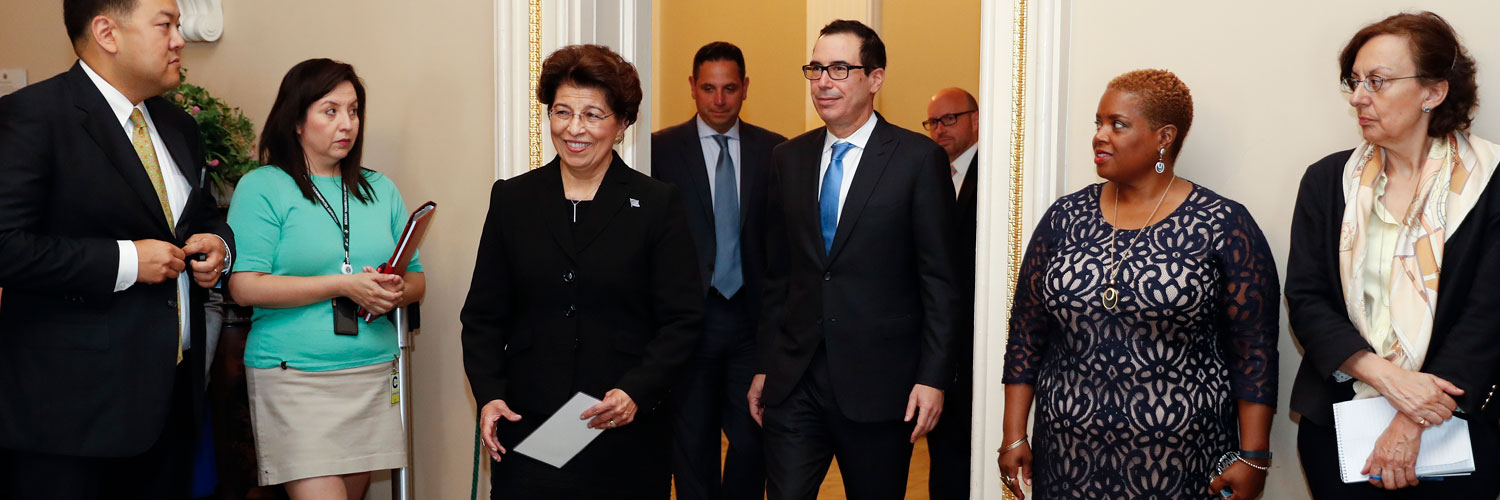
<p>Treasury Secretary Steven Mnuchin and Jovita Carranza arrive at the Treasury Department in Washington on June 19th, where Mnuchin will administer the oath of office to Carranza as the 44th Treasurer of the United States. On July 28th, the Treasury Department announced its plans to terminate myRA. Photo by Carolyn Kaster/AP.</p>
In late July, the US Treasury Department announced it was terminating the myRA program, the latest federal effort to boost retirement savings. The program, launched two years ago, enabled participants to contribute to a tax-preferred retirement account through automatic payroll deductions.
But myRA never caught on, partly because it didn’t automatically enroll workers, a feature of the Obama administration’s proposed national retirement savings program that stalled in Congress. MyRA enrolled just 30,000 workers, which was not enough to justify the cost of running the program, according to the Treasury.
With the demise of myRA, state retirement initiatives may now offer the best hope to boost retirement savings. These initiatives can learn from myRA’s failure.
Many workers don’t save enough for retirement
Only about half of all workers and two-thirds of full-time workers participate in a retirement plan at work, which is how most people amass retirement savings. Fifty million workers lack access to an employer retirement plan. Some accumulated retirement savings through past jobs or will do so through future jobs, while others have a spouse with an employer retirement plan, so more workers eventually accumulate work-based retirement savings than participate in a retirement plan at a given time.
Nonetheless, about one-third of adults ages 65 and older lack income from an employer pension or retirement account. Without retirement savings, retirees must rely primarily on Social Security, which doesn’t typically pay enough to retire comfortably.
What went wrong with myRA?
To address the retirement savings shortfall, the Obama administration launched the myRA program. Restricted to workers whose employers didn’t offer a retirement plan, it allowed enrollees to contribute up to $5,500 a year (or $6,500 a year if they were age 50 or older) to an account resembling a Roth IRA. Participants pay taxes on their contributions, but they can generally withdraw funds tax free after age 59 and a half. The program invested myRAs in US Treasury savings bonds paying safe, low-yield returns.
The myRA program was designed as a “starter” retirement plan. Once workers accumulated $15,000, their balances would be rolled over to a private-sector retirement account. To make savings a habit, myRAs allowed participants to fund their accounts through automatic payroll deductions.
So what went wrong? Like most programs, myRA required participants to sign up, and once they did, they could save automatically. But few workers enrolled because they either didn’t know about the program or didn’t complete the paperwork.
The spotlight shifts to the states
Even before the demise of myRA, states had begun to tackle the retirement challenge. Over the past five years, more than half the states have considered initiatives to promote retirement savings. Nine states—California, Connecticut, Illinois, Maryland, Massachusetts, New Jersey, Oregon, Vermont, and Washington—have enacted retirement savings programs that will launch in the coming years.
Many of these programs resemble myRAs but have a better chance of success because they tap into the power of defaults. Behavioral economics teaches us that defaults shape behavior, as many people simply follow guidelines from employers and the government. Evidence shows that employers can raise participation in 401(k) retirement plans by more than 25 percentage points by automatically enrolling employees. Employees can opt out, but few do.
Based on this evidence, many of the forthcoming state retirement plans will automatically enroll employees instead of waiting for employees to sign up. California’s Secure Choice Retirement Plan, for example, will require employers with five or more employees that don’t offer a retirement plan to automatically enroll their employees into IRA-type accounts funded by direct payroll contributions. Because participation will be the default option, enrollment rates will likely be higher than in the myRA program.
State-run retirement plans still face significant hurdles. They must find appropriate investment and distribution options and figure out how to cover administrative costs. Because the plans can’t generally accept employer contributions, account balances in state-run plans will never grow as rapidly as in 401(k) plans.
The federal government recently complicated these state efforts further. In May, President Trump signed legislation rescinding rules set by the Obama administration that provided regulatory relief to state-run IRAs. State officials say this legal uncertainty won’t derail state retirement initiatives, but it could create delays.
Nonetheless, the lessons learned from the end of the myRA program can guide state retirement initiatives, which offer the best chance of improving retirement prospects for the 50 million workers who lack access to an employer retirement plan.
Let’s build a future where everyone, everywhere has the opportunity and power to thrive
Urban is more determined than ever to partner with changemakers to unlock opportunities that give people across the country a fair shot at reaching their fullest potential. Invest in Urban to power this type of work.